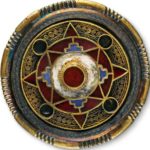A group for discussing magical and non-magical rune lore.
Germania: An Argument for Continuity in Sortilege
Tagged: Divination
- This topic has 2 replies, 1 voice, and was last updated 1 month, 1 week ago by
 Rob Holman.
Rob Holman.
-
AuthorPosts
-
-
February 15, 2025 at 2:59 pm #4591
 Rob HolmanKeymaster
Rob HolmanKeymasterIn Chapter 10 of Germania, Tacitus describes a Germanic ritual involving the cutting of twigs from a fruit-bearing tree, marking them with symbols, and casting them onto a white cloth for divinatory purposes. While Tacitus does not specify what these marks were, applying Occam’s Razor and historical context makes it highly probable that the marks were runes, or at the very least, proto-runic symbols.
What Were the Marks on the Twigs?
Tacitus mentions that the lots were marked with symbols that were interpreted when drawn at random. The most plausible explanation is that these symbols were runes for several reasons:
1. Runic Origins Align with Tacitus’ Timeframe
The Elder Futhark, the earliest known runic alphabet, dates to at least the 2nd century CE, but linguistic evidence suggests it existed earlier. Tacitus wrote Germania in 98 CE, well within the period when runes could have been in use.
2. Lack of Alternative Symbol SystemsNo evidence of any other formalized system of symbolic marks used for divination in early Germanic culture exists. While abstract notches or lines are possible, it is far more likely that early runes served both practical and mystical purposes, including divination.
3. Tacitus’ PerspectiveTacitus was writing for a Roman audience unfamiliar with Germanic culture. The word “runes” (from Proto-Germanic rūnō, meaning “mystery” or “secret”) would have had no Latin equivalent. Describing them as marked twigs was likely the simplest way to convey the concept.
Sortilege as an Enduring Tradition
Even if we entertain the idea that the symbols were not runes, this does not weaken the legitimacy of using runes for divination today. The method Tacitus describes—casting lots to gain insight—is ancient and universal. The act of drawing lots (sortilege) is far older than runic writing itself, and the adoption of runes for this purpose would have been a natural evolution of the practice.
Runes as the Perfect Symbolic System for Sortilege
Later Norse sources, such as Hávamál and Sigrdrífumál, describe the magical and esoteric power of runes. These texts strongly suggest that runes were more than a writing system—they were tools of divine communication and fate manipulation.
• Runes bring meaning and structure to sortilege, enhancing the practice beyond simple chance.
• Each rune carries layered meanings, allowing the practitioner to draw on cultural, spiritual, and psychological insights.Modern Rune Casting: A Continuation, Not a Reinvention
The lack of explicit mention of runes in Tacitus’ account does not diminish the legitimacy of modern rune casting. On the contrary, it reinforces its place within an ancient tradition of divination by sortilege. The use of runes as symbolic tools for insight is a logical continuation of the method Tacitus described, whether or not the early Germans used fully developed runes at the time.
• Runes today serve as both practical symbols and spiritual keys, offering practitioners a direct link to their ancestors’ methods of seeking knowledge from the divine or their own subconscious.
• Sortilege evolves with culture, and the symbolic set used—whether ancient or modern—remains valid as long as it functions within the same framework.Conclusion
Tacitus’ account in Germania strongly suggests that early Germans practiced sortilege using symbols that were most likely early runes. Even if these symbols were not fully developed runes, the practice of casting lots for divination provides a direct precedent for modern rune casting. Rather than weakening the case for runic divination, the broad framework of sortilege strengthens it. Using runes today is not only consistent with ancient traditions—it enriches and extends them in a meaningful and culturally grounded way.
-
February 21, 2025 at 10:09 am #4618
 Rob HolmanKeymaster
Rob HolmanKeymaster@thehoptimist asks:
Was there one symbol on each twig in the account of Tacitus, and second:
Were the Runes fist used for this purpose and then for writing, or vise versa?
On the first; we don’t know. What is said in Germania is literally our only account of the rite. We have no real way to know, but one seems logical, unless we think there were entire words written on them, which seems counterintuitive.If they are ideograms here, it would be best to break the ideas down to their most basic form, so they can provide the widest range of answers.
On the second: As the staves were probably derived in very early times from Etruscan, it is most probable in my view they were symbols for writing first, or that they were ideograms AND letters, that were then put to use for sortilege.
-
February 21, 2025 at 10:15 am #4619
 Rob HolmanKeymaster
Rob HolmanKeymasterIt is important to add I think, that the older rune poems like the OE Rune Poem, associate the runes with ideas… but do NOT teach you how to say it. For example:
Eolh-secg eard hæfþ oftust on fenne
wexeð on wature, wundaþ grimme,
blode breneð beorna gehwylcne
ðe him ænigne onfeng gedeþ.Elk-Sedge grows oftenest on the fen
It flourishes in water, and grimly wounds
burns the blood, of any man whomsoever
grasps itMore or less. Now, can a newcomer to runes read this stanza, and tell me from this reading… what sound this one makes??
-
-
AuthorPosts
- You must be logged in to reply to this topic.
